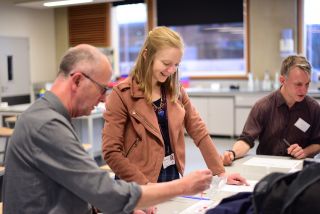Activities with schools are an integral part of the public engagement activities at the MRC WIMM, often involving visits to and from schools, or work experience placements within our laboratories. However, the Eggeling and Cerundolo groups at the MRC Human Immunology Unit wanted to try a complementary approach. They set themselves the challenge of creating a set of activities that teachers could use year after year to deliver the science curriculum connected to MRC HIU research in an engaging and enriching way. To help with this project, the researchers collaborated with Abingdon Science Partnership, a science outreach organisation based at Abingdon School that aims to strengthen participation in science across the Abingdon district and beyond. A major element of this partnership was identifying key curriculum learning objectives for 10-11 year olds in the area of expertise of each lab.
Laser pointers and lego
The group of Prof Christian Eggeling specialises in the application and development of cutting edge super-resolution microscopy, and hence focused in the development of teaching resources that introduced basic concepts of microscopy. They developed a series of interactive activities exploring basic properties of light using easily available materials. These basic concepts were unpacked in a step-by-step activity where students have the opportunity of building a simple, but functional microscope, using only a laser pointer, a syringe and lego. Students could then explore basic concepts of cell biology by observing microscopic organisms from pond water. "Microscopy always captivates people from all ages and building one with very simple elements is even more interesting.” Explains Erdinc Sezgin, a researcher from the Eggeling group “This activity is carefully designed to engage students with a broad spectrum of interests. The process of building involves engineering while the optical parts are fun for students interested in physics, and the self-found sample is more interesting for those passionate for biology. All of these aspects encourage creativity"
The importance of antibodies

‘An engaging workshop’
These activities and resources were presented to teachers from schools across Oxfordshire in a free workshop run at Abingdon Science Partnership this month. Teachers tried out the activities and lesson plans, while also having the opportunity to hear presentations on the latest research at MRC HIU and its connection to the resources provided. The initial feedback from teachers following the workshop was very positive, with one participant saying “I found that these are effective practical activities that can be performed on a limited budget. The preparation would be easy, and presenters gave good tips for the best results.” Another teacher stated “Found the laser pen and water droplet amazing. Already using it today.” All teachers that attended stated that they agreed or strongly agreed with the statement that the workshop had been a good use of their time and that the practical activities will be a valuable learning experience for students.
“I really like the idea of inspiring the next generation of scientists, especially those who don’t even think of themselves as scientists but whose curiosity can be sparked by letting them have a go themselves.” said Corinna Kulicke, a DPhil student in the group of Prof Cerundolo who participated in the project .“I enjoy going into schools with hands-on activities but running this workshop brought a whole new dimension to the activities we developed and working with adults rather than kids was a really cool experience. I hope that the material will be useful for teachers and used in class rooms throughout the UK in the future so that the kids have as much fun doing the activities as we had designing them”. The resources developed will be available online in the near future.


